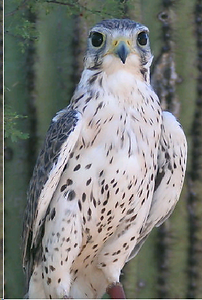

© 2005 Marta Hernandez, Arizona-Sonora Desert Museum, Tucson, AZ. This picture was taken by
a Raptor Free Flight trainer at the Arizona-Sonora Desert Musuem.
Introduction
The Prairie Falcon is a cold-hardy and heat-tolerant raptor that is found primarily in the dry land. They can usually be found near dry places. This website will talk about how the Prairie Falcon survives in harsh conditions like those found in the Sonoran Desert.
Content
Prairie Falcons live in the hills, canyons, and mountains of arid grasslands and shrug-steppes of southwestern Canada, the western United States, Baja California, and Northern Mexico. Their primary diet is smaller size birds, and they also hunt small mammals like squirrels, rabbits, mice, reptiles and insects, Yum. Prairie Falcons catch prey on the ground or close to the ground. HOW? The Prairie falcon is known for its fast diving, alternating a number of fast strokes with short glides, very fascinating. Most of the hunting is done within thirty meters of the ground. They lay five eggs at the nest that is high enough to keep it out reach from predators. If you click on the website below, it has more information and also pictures of Prairie Falcons.
The Peregrine Fund: Peregrine Falcons

© 2005 haustka1, The Western Scrub Jay is approximately 10 inches in length, and could be falcon food, although it may be a little big for Prairie Falcon to eat.
General Identification
Prairie Falcons have these Characteristics
- Like other falcons, the paririe falcon can be distinguished from hawks in flight by tip pointed wings.
- They have light brown feathers on their back and pale feathers on their front. Prarie falcons may also have a dark mustache on their pale face and a dark area beneath the wing area.
- They make "Kree-Kree-Kree" sounds
- Their full length is about 16 inches, and Wingspan is about 40 inches
- They have a short beak that is a dark grayish color
- They have a dark brown cap and cheek and a brown tail
- The wing tips fall a couple inches short of the tail on a perched bird
- When they are immature, Prairie Falcons lack pale bars on their back feathers, making the back appear darker, and they have more heavily streaked underparts.
- As it grows an adult, the prarie falcom acquires pale brown bars on their back feathers, and their whitish underparts have only a few dark streaks on the breast and a few spots on the belly.
Population
They are currently declining, in some places due to habitat loss, and possibly due to nest robbing by people and rodent poisining.
Extra Facts
Young Prairie Falcons have 75 percent of chance to survive to become a adult. Even though they can live up to 20 years, the average lifespan is less than 3 years.
Conclusion
Prairie falcons are very interesting birds, and their numbers are currently declining. It is important to study Prairie falcons to preserve and protect them.
More information and pictures are provided at the websites listed below.
Information on the Internet
- Prairie Falcon Falco mexicanus This website shows identification tips for Prairie Falcon and shows some pictures.
- Santa Cruz Predatory Bird Research Group This website shows the facts about the Prairie Falcon.
- Praririe Falcon (Falco mexicanus) This website contains photo and facts about the Prairie Falcon.



 Go to quick links
Go to quick search
Go to navigation for this section of the ToL site
Go to detailed links for the ToL site
Go to quick links
Go to quick search
Go to navigation for this section of the ToL site
Go to detailed links for the ToL site